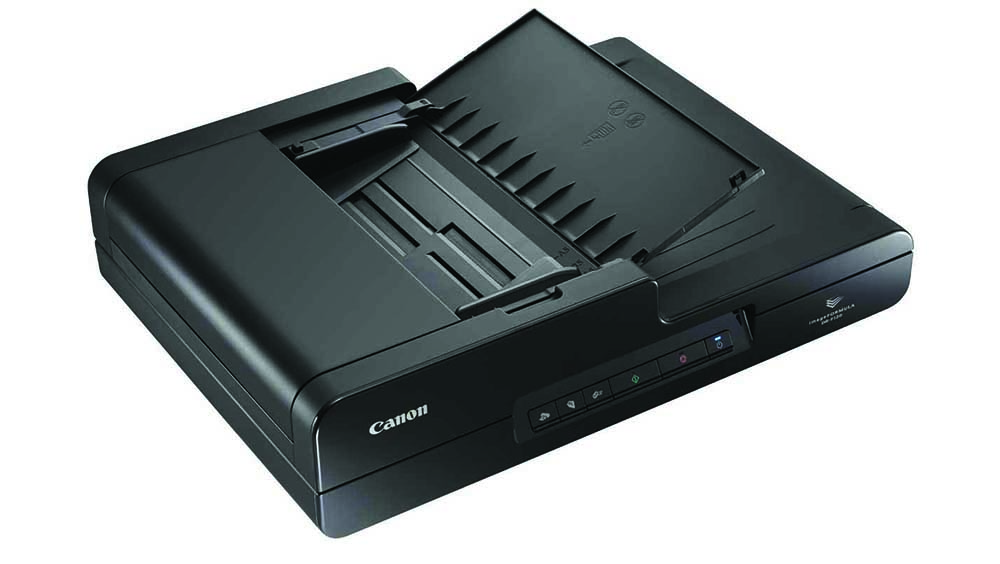Canon imageFormula DR-F120 review
It’s not fast, and software is minimal, but this little scanner delivers good results at a tempting price

The DR-F120 is good value for a combined ADF/flatbed
-
+
Good value; Scanning software is fast and capable;
-
-
Slow jam detection; Takes a long time for high dpi colour scans; No bundled document management software

Small businesses seeking a low-budget scanner will find Canon's DR-F120 fits the bill nicely. It teams a 20ppm ADF and an A4 colour flatbed scanner with Canon's intuitive CaptureOnTouch software at a persuasive price.
It's comparatively small, too, measuring only 469 x 335 x 120mm (WDH). The flip-up, 50-sheetADF paper tray increases heightto 151mm. The device is well built, with solid ADF paper supports and a strongly hinged flatbed lid that can be raised up by 12mm. The ADF is built into the lid, so you can't remove the top for thicker items.
The scanner's single USB 2 port means you can only connect one PC. If you want to network it, you'll have to add an external USB device server such as the Silex SX-DS-4000U2; the 100 cost makes this less appealing.
The scanner doesn't come with any document-management software, but the supplied CaptureOnTouch scanning software is very capable, enabling quick scans to TIFF, JPEG, BMP, PPTX, PNG and PDF formats and it's cloud-ready.
The interfacemakes light workof creatingshortcuts. Start bycreating a documentprofile and setting up colour or mono scanning, choosing a resolution and specifying simplex or duplex.
You can also enable other image tools, such as anti-skew. These are linked to output profiles, which determine where the scan is sent. Local or network folders and printers are supported, or you can enable OCR and assign your scan to one of the cloud plugins.
This is easy to set up: we were scanning to Evernote in minutes. Once we'd entered our account details in the output profile, we could restrict access to a specific period and create new notebooks for our scans.
Google Drive was equally easy to configure, while for Dropbox and OneDrive, we simply pointed the software at local sync folders. SugarSync and SharePoint are also supported, and there's an option to send scans as attachments using your default email client.
Performance is greatly affected by whether or not you scan in colour: greyscale duplex scans of 30 bank statements to PDF were processed at 19ppm at both 200dpi and 300dpi.
Switching to a 24-bit colour profile saw speed dip to 9ppm at 200dpi and 6.3ppm at 300dpi. Don't bother trying to scan at 600dpi in colour: this slowed things to a yawn-inducing 1.6ppm, and took a further 2mins 32secs to convert the scan to PDF.
Paper handling during these tests was reasonably good, but the ADF paper path sends documents around a 180-degree bend, so you'll need to use the flatbed for thick originals. We suggest you do the same for thin documents: jam detection is sluggish, and a feed error led to some of our test receipts getting damaged.
When you use the flatbed, make sure there's nothing in the ADF before starting a scan. Book and document scans matched our results from the ADF, but photos suffered from a lack of focus caused by a nasty cross-hatching effect.
Still, scanning in greyscale at 200dpi produced results suitable for archiving purposes. The software's built-in OCR option delivers searchable PDFs, and we found accuracy was superb at 200dpi.
With its low speeds, the DR-F120 isn't suitable for archiving large volumes of paperwork, and you may need to factor in the cost of extra document processing software. Even so, Canon's CaptureOnTouch utility is effortlessly simple and the DR-F120 is good value for a combined ADF/flatbed.
This review first appeared in PC Pro magazine issue 252
Verdict
The DR-F120 is good value for a combined ADF/flatbed
600dpi optical resolution colour
ADF/ flatbed
20ppm at 200dpi mono
10ppm at 200dpi colour
Simplex/duplex
50-page ADF
USB2
External PSU
Daily duty cycle, 800 pages
Canon CaptureOnTouch 3 software
TWAIN/ISIS drivers
469 x 335 x 120mm(closed, WDH)
1yr advanced exchange warranty
Get the ITPro daily newsletter
Sign up today and you will receive a free copy of our Future Focus 2025 report - the leading guidance on AI, cybersecurity and other IT challenges as per 700+ senior executives
Dave is an IT consultant and freelance journalist specialising in hands-on reviews of computer networking products covering all market sectors from small businesses to enterprises. Founder of Binary Testing Ltd – the UK’s premier independent network testing laboratory - Dave has over 45 years of experience in the IT industry.
Dave has produced many thousands of in-depth business networking product reviews from his lab which have been reproduced globally. Writing for ITPro and its sister title, PC Pro, he covers all areas of business IT infrastructure, including servers, storage, network security, data protection, cloud, infrastructure and services.
-
 Nvidia braces for a $5.5 billion hit as tariffs reach the semiconductor industry
Nvidia braces for a $5.5 billion hit as tariffs reach the semiconductor industryNews The chipmaker says its H20 chips need a special license as its share price plummets
By Bobby Hellard Published
-
 Business leaders are having a crisis of confidence over data literacy
Business leaders are having a crisis of confidence over data literacyNews A Salesforce survey reveals business leaders don't trust their data, or their ability to make the most of it
By Emma Woollacott Published
-
 Confusion and frustration as MITRE CVE program funding expires
Confusion and frustration as MITRE CVE program funding expiresNews The cyber database is invaluable to security teams the world over, helping flag the most urgent vulnerabilities
By Rory Bathgate Published